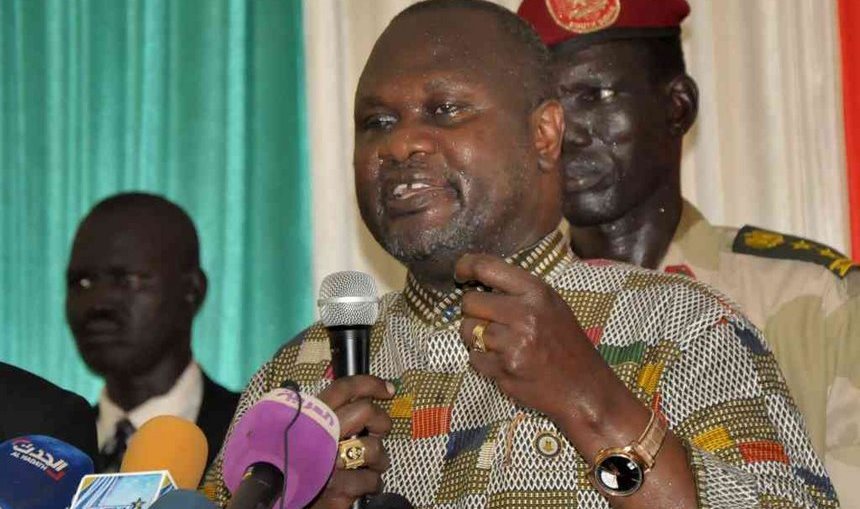The Intergovernmental Authority on Development (IGAD) made a summary of different positions of the three groups that participated in the intensive interlinked consultations in Addis Ababa. Here are some positions of the SPLM-IO obtained by Radio Tamazuj.
Composition of the revitalized transitional government
- The SPLM/A-IO proposed that the TGoNU, SPLM-IO, SSOA and other political parties invited by IGAD at the HLRF shall participate in the government.
Structure of transitional government (including the question of federalism):
- The SPLM/A-IO proposed federalism as a system of governance during the transitional period
- The SPLM-IO proposed that the presidency shall consist of a president nominated by the current TGoNU but not the incumbent, a Frist Vice President nominated by SPLM/A-IO, and a Vice President nominated by other political parties and SSOA. It was also proposed that the powers of the members of the presidency shall remain as stipulated in the 2015 peace agreement.
- SPLM/A-IO proposed to retain the current 30 ministers, share on a ratio of 40% for SPLM/A-IO: 40% for current TGoNU: and 20% for SSOA and other political parties. SPLM/A-IO proposes the responsibly sharing ratio shall also apply to Commissions, Authorities and parastatals.
Responsibility sharing allocations
- The SPLM/A-IO proposed that the responsibility sharing formula based on the following ratio: power sharing ratio: SPLM/A-IO %40: TGoNU 40%, and SSOA and OPP 20%. These ratios will be applied at all levels of government structures.
- They also suggested that the responsibility sharing formula shall also be applied to boards, commissions, and chairpersons of parliamentary committees.
Number of States
- The SPLM/A-IO proposed that the 10 states agreed to in the 2015 peace agreement should remain
- The SPLM/A-IO proposed that the commissioners and councilors be elected. However, during the transitional period, they shall be appointed in accordance with the above responsibility sharing ratio.
Size and compositing of the legislature
- The SPLM/A-IO proposed that the current parliament be dissolved and a new transitional parliament be reconstituted with 170 members representing 170 constituencies, and the responsibility sharing formula of 40; 40; and 20 be applied. However, the SPLM-IO expressed flexibility on the size of the legislature by further proposing a parliament of 220 members.
- SPLM-IO would like to retain 50 seats as the 2015 peace agreement, but proposes the reconstitution of the Council of States with the above responsibility sharing formula.
Principle of Unification of Forces
- The SPLM/A-IO proposes that the SPLA and other security services are not national in character and unprofessional. Therefore all military forces including the SPLA-IO must be disbanded and cantoned, and then select those qualified to form a new army and other national security services.
- SPLM/A-IO also stressed that during the transitional period, the current security services cannot create a conducive environment for elections since they have been involved in human rights abuses and hence the need to screen those need to form new security services.
Timeframe for establishment of new army
- SPLM/A-IO proposed 18 months as sufficient time to complete the establishment of the new army. They also proposed that the first batch of police force can be rollout in 12 months.
- In addition, they noted that the timeframes for the unification of forces should not be tied to the pre-transitional period since some activities might be completed during the pre-transition period, transition, and after transition.
Establishment of new security sector
- The SPLM/A-IO proposed that the establishment of a new security sector be based on SDSR Board outcome which shall include objectives criteria for the selection of candidates for the new security services. They also proposed that the new army be composed of equal numbers from each party, and the transitional government shall allow a 20% new recruits.
Demilitarization
- The SPLM/A-IO proposed that all forces be cantoned in order to create a security environment for civilians, and that all cantonments be sited far away from civilian centers and in accordance with the cantonment criteria stipulated in the 2015 peace agreement. They also emphasized the importance of moving weapon storages and weapons out of civilian centers.
Security of civilians and VIPs
- The SPLM/A-IO proposed that the protection of citizens including VIPs be provided by UNMISS/RPF during the transition until the establishment of security services. They highlighted the importance of a ceasefire and IGAD to enforce the ceasefire and the cantonment of forces.




